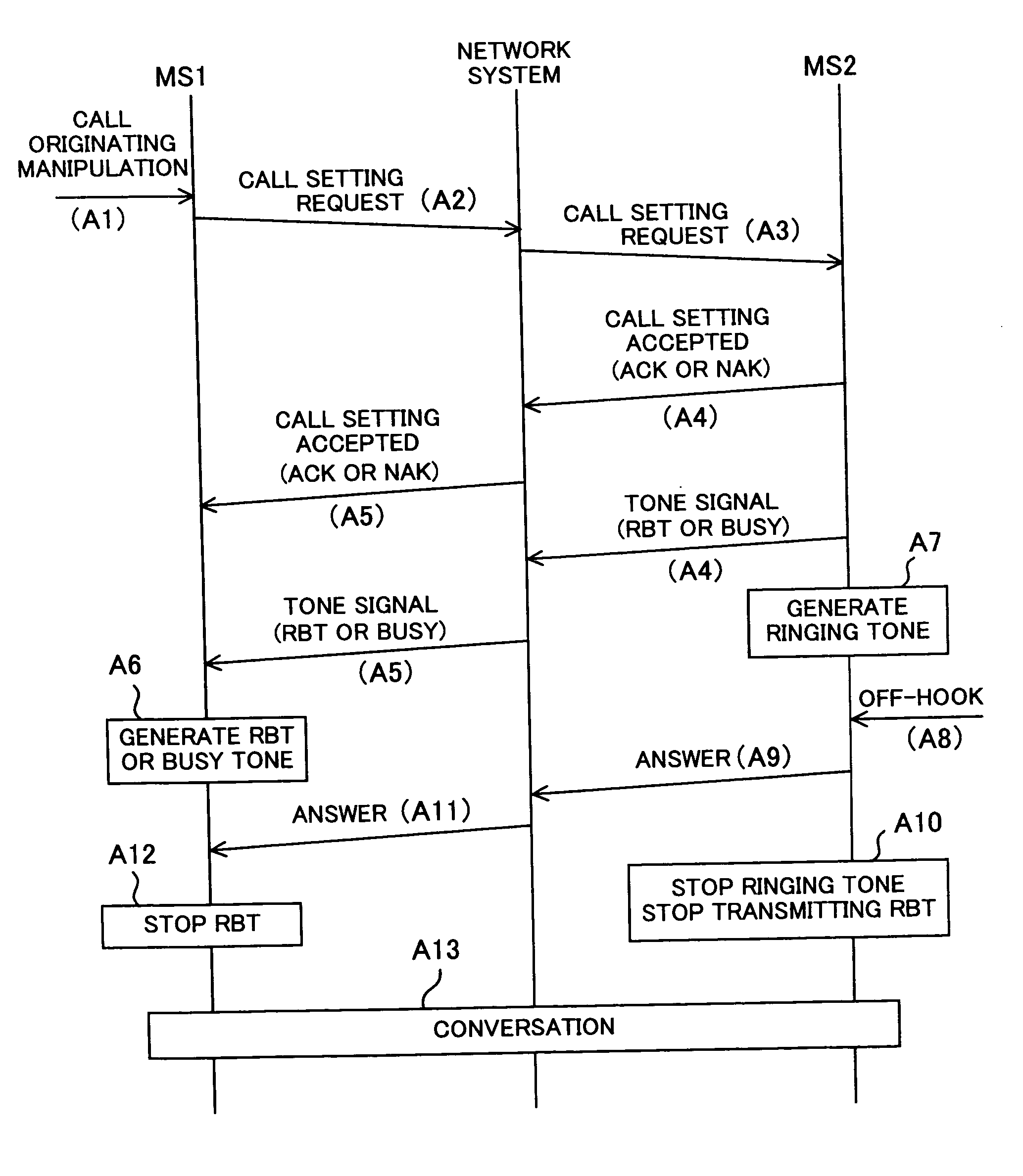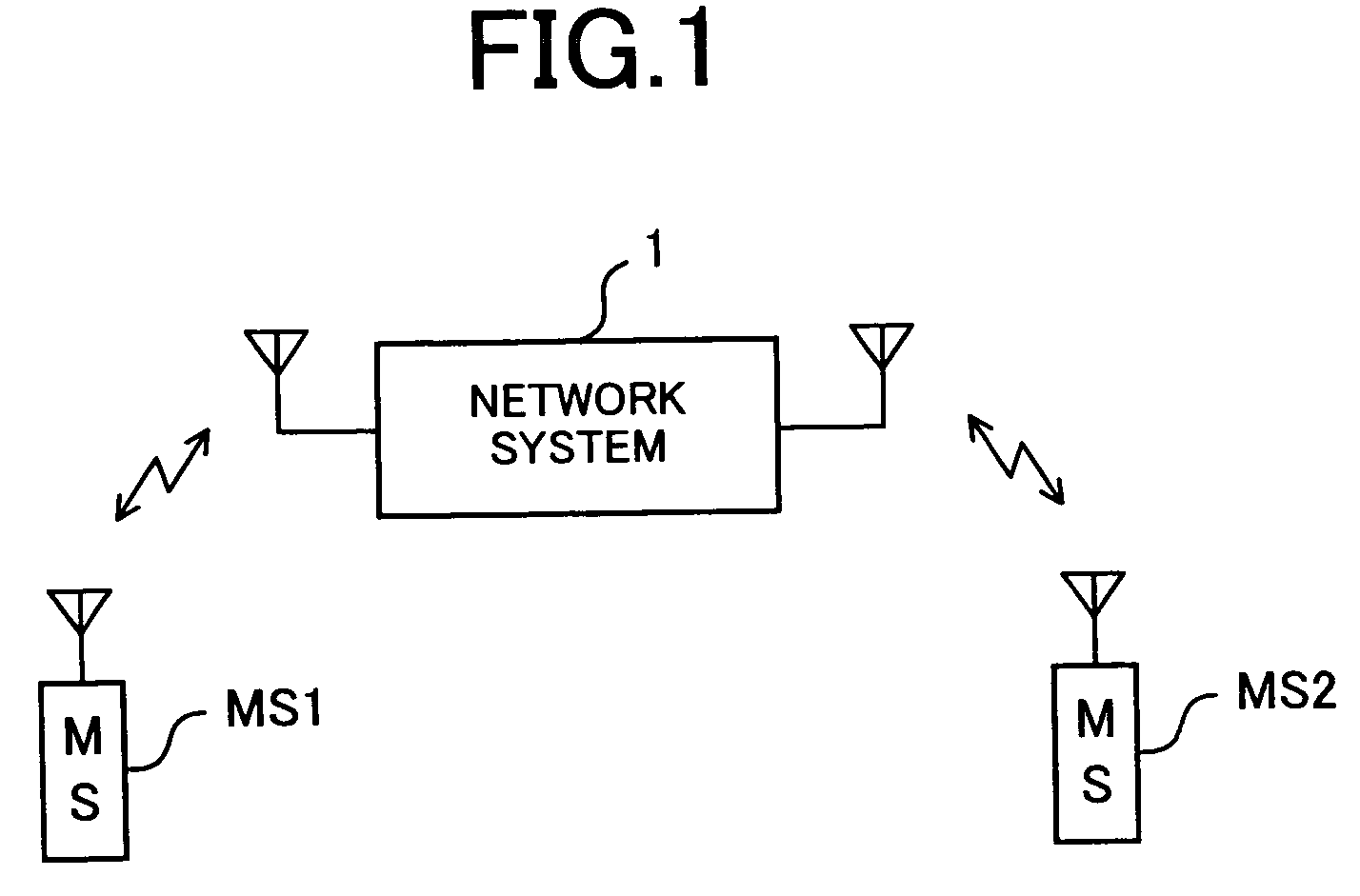Wireless telephone and wireless telephone system
a wireless telephone and telephone system technology, applied in the field of wireless telephone and wireless telephone system, can solve the problem that the user cannot be informed of the operating state of the called telephone in the user's original representation form, and achieve the effect of improving the service of the user
- Summary
- Abstract
- Description
- Claims
- Application Information
AI Technical Summary
Benefits of technology
Problems solved by technology
Method used
Image
Examples
embodiment 1
[0031]FIG. 1 is a conceptual diagram showing the entire construction of a mobile telephone system using wireless telephones according to embodiment 1 of the invention. This mobile telephone system conforms to, for example, 3G (3 Generation) standards such as W-CDMA, UMTS (Universal Mobile Telecommunication System) and cdma2000, 2.5G (2.5 Generation) standards such as IS-95, or 2G (2 Generation) standards such as PDC (Personal Digital Cellular) and GSM (Global System for Mobile Communications), and is provided with a plurality of mobile telephones MS1 and MS2 (hereinafter also referred to generally as “mobile telephone MS”) and a network system 1.
[0032]FIG. 2 is a sequence diagram for explaining call setting processing in the above-described mobile telephone system. For example, consideration will be given to a case where a call is made from one mobile telephone (hereinafter referred to as “calling mobile telephone”, as the need arises) MS1 to another mobile telephone (hereinafter re...
embodiment 2
[0062]FIG. 7 is a sequence diagram for explaining processing during call setting in a mobile telephone system according to embodiment 2 of the invention.
[0063]In the above-described embodiment 1, the tone data registered in the called mobile telephone MS2 is transmitted to the calling mobile telephone MS1, whereby the user's original melody or sound of the called mobile telephone MS2 is generated from the calling mobile telephone MS1. In contrast, in this embodiment 2, tone data is previously registered not in the called mobile telephone MS2 but in the calling mobile telephone MS1, and in the case where the calling mobile telephone MS1 receives call setting accepted data after having originated a call, the calling mobile telephone MS1 generates an RBT or a busy tone on the above-described registered tone data. In this manner, the user of the calling mobile telephone MS1 can hear an original RBT or busy tone suited to the user's preference from his / her own mobile telephone MS. Accord...
embodiment 3
[0070]FIG. 8 is a block diagram showing the internal construction of the mobile telephone MS according to embodiment 3. In FIG. 8, the same reference numerals are used to denote the same functional parts as those shown in FIG. 3.
[0071]In the above-described embodiment 1 or 2, dedicated tone data are registered in the mobile telephone MS as RBT and busy tone. In contrast, in this embodiment 3, ringing tone data already registered in the mobile telephone MS as data for generating a ringing tone is utilized as data for RBT or busy tone. Accordingly, embodiment 3 has the advantage that the mobile telephone MS does not need a storage area dedicated to tone data.
[0072]More specifically, ringing tone data, in addition to user data, is stored in the second memory part 14 of the mobile telephone MS according to this embodiment 3. The ringing tone data is data on a ringing tone to be generated when an incoming call is received, and, for example, is stored previously or is stored by being down...
PUM
 Login to View More
Login to View More Abstract
Description
Claims
Application Information
 Login to View More
Login to View More - R&D
- Intellectual Property
- Life Sciences
- Materials
- Tech Scout
- Unparalleled Data Quality
- Higher Quality Content
- 60% Fewer Hallucinations
Browse by: Latest US Patents, China's latest patents, Technical Efficacy Thesaurus, Application Domain, Technology Topic, Popular Technical Reports.
© 2025 PatSnap. All rights reserved.Legal|Privacy policy|Modern Slavery Act Transparency Statement|Sitemap|About US| Contact US: help@patsnap.com



